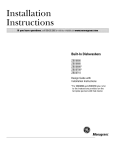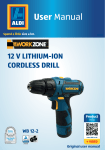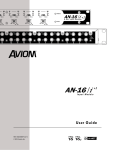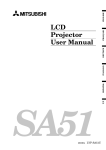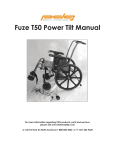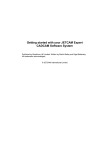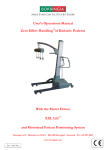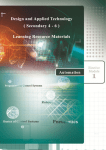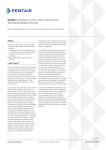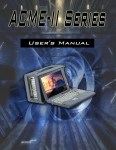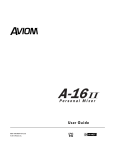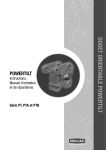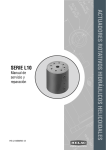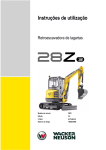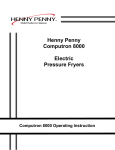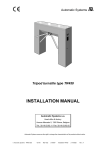Download POWERTILT - Helac Corporation
Transcript
® Instruction, Service and Repair Manual PT, PTA and PTB Series Optional PowerTilt Pin Grab Coupler POWERTILT SWING ATTACHMENT POWERTILT INTRODUCTION Table of Contents Introduction Table of Contents........................................................................................................................................................ 2 Product Overview....................................................................................................................................................... 3 Operation Technology................................................................................................................................................. 5 General Safety Guidelines.......................................................................................................................................... 6 Product Identification.................................................................................................................................................. 7 Installation and Maintenance Installation and Mounting............................................................................................................................................ 8 Hydraulic Requirements and Plumbing.................................................................................................................... 10 Maintenance............................................................................................................................................................. 13 Trouble Shooting Guide ........................................................................................................................................... 14 Tools Tools Required ......................................................................................................................................................... 15 Drawings Assembly Drawings.................................................................................................................................................. 16 Piston Drawings ....................................................................................................................................................... 20 Exploded View.......................................................................................................................................................... 21 Parts List .................................................................................................................................................................. 22 Disassembly Component Identification.......................................................................................................................................... 23 Product Inspection.................................................................................................................................................... 24 Standard Pin-on Coupler Removal .......................................................................................................................... 24 End Cap, Lock Ring and Cross Port Relief Valve Removal ..................................................................................... 26 Shaft Removal.......................................................................................................................................................... 27 Piston Sleeve Assembly Removal............................................................................................................................ 28 Seal and Bearing Removal....................................................................................................................................... 29 Component and Timing Mark Inspection.................................................................................................................. 30 Assembly Dry Assembly ........................................................................................................................................................... 31 Seal and Bearing Installation ................................................................................................................................... 31 Piston Sleeve Installation ........................................................................................................................................ 35 Shaft Installation....................................................................................................................................................... 36 End Cap and Lock Ring Installation......................................................................................................................... 37 Cross Port Relief Valve Installation........................................................................................................................... 38 Standard Pin-on Coupler Installation........................................................................................................................ 39 Post Assembly Testing and Greasing ............................................................................................................................................... 43 Optional PowerTilt Pin Grab Coupler Operation and Maintenance .................................................................................................................................... 45 Warranty Warranty Information ............................................................................................................................................... 63 2 INTRODUCTION Product Overview Product Introduction Content in this Instruction, Service and Repair Manual applies to all current product models unless noted otherwise. For information on maintaining, servicing or repairing earlier product models (TT, TTB and TBB series) please contact your local dealer or Helac's Service Department at 1-800-7978458 (US and Canada) or email at repairs@helac. com. Helac PowerTilt®, a construction equipment attachment from Helac Corporation, can increase the productivity, profitability and versatility of backhoes or excavators by simply tilting the attachment instead of moving the entire machine. PowerTilt is ideal for performing everyday tasks, or completing jobs that haven't been tried. Thousands of contractors worldwide have come to rely on PowerTilt since 1990 for cleaning ditches, clearing land, digging beveled trenches, spreading rip-rap, and positioning brushcutters, mowers and hydraulic hammers. When used in combination with Helac PowerGrip®, a multi-purpose bucket, companies can achieve unmatched , hand-like manipulation and dexterity, dramatically maximizing productivity. 3 INTRODUCTION Product Overview INTRODUCTION Product Overview Basic Configurations Basic Configurations PT Series PTA/PTB Series Custom Designs PT Serieshousing with welded-on ears. Custom Designs PTA/PTB Standard TheSeries housing and shaft are designed Depending on the Lower end can be welded directly to a Standard housing with welded-on quickLower coupler orcan bucket. ears. end be welded directly to a quick coupler or bucket. for customization. Ideal for integrating order quantity, Depending on the order The housing and shaft are couplers at both the top quantity, custom-engineered custom-engineered designedquick for customization. Ideal and bottom. Seriesathousingconfigurations is configurations can be can be provided. for integrating quick PTA couplers both thedesigned top and bottom. for welding; PTB Series provided. PTA Series housing is designed housing incorporates drilled and for welding; PTB Series housing tapped holes for bolt-mounting. incorporates drilled and tapped holes for bolt-mounting. Specifications for PT, PTA and PTB Series Model Size 6 7 8 9 10 11 12 20,000 (9,100) 28,700 (13,000) 45,000 (20,000) 60,000 (27,000) 75,000 (34,000) Maximum Machine Weight lb (kg) 10,500 (4,775) 15,000 (6,800) Approximate PowerTilt Weight* lb (kg) 180 (85) 320 (145) 425 (195) 575 (260) 850 (385) 1,200 (545) 1,500 (680) 180°** 180° 180° 134° 134° 134° 134° 165,000 (18,640) 220,000 (24,860) Total Tilt Output Torque in-lbs (Nm) 25,000 (2,820) 42,000 (4,740) 63,000 (7,110) 94,000 (10,620) 130,000 (14,690) Holding Torque in-lbs (Nm) 50,000 (5,640) 84,000 (9,480) 126,000 (14,220) 188,000 (21,240) 260,000 (29,380) 330,000 440,000 (37,280) (49,720) * Weights may vary depending on model size. Approximate weights for PTA and PTB Series do not include mounting brackets or couplers. ** Actual rotation may vary slightly. 4 4 INTRODUCTION Operation Technology PowerTilt uses Helac Corporation’s innovative, sliding-spline operating technology to convert linear piston motion into powerful shaft rotation. Each actuator is composed of a housing and two moving parts — the central shaft and piston. Helical spline teeth on the shaft engage matching teeth on the piston’s inside diameter. A second set of splines on the piston’s outside diameter mesh with the gear in the housing. Starting position The piston is completely bottomed out. Bars indicate starting positions of piston and shaft. Arrows indicate directions they will rotate. The housing with integral ring gear remains stationary. Ending position When hydraulic pressure is applied to the piston, it moves axially, while the helical gearing causes the piston and shaft to rotate simultaneously. Applying pressure to the opposite port will return the piston and shaft to their original starting positions. 5 INTRODUCTION General Safety Guidelines Cautionary Notices Before beginning disassembly of the PowerTilt, there are several cautionary notices that should be considered. If you are not comfortable with repair or maintenance of this product, contact your local dealer or Helac Corporation's Service Department for assistance. Other Safety Guidelines and Precautions 1. PowerTilt should only be used to perform tasks for which it was designed. Abusing the product and/or using it for purposes for which it was not intended can expose the operator and others to hazards as well as result in damage to the PowerTilt, carrier and/or other attachments. 2. Modification to the PowerTilt is done at the owner’s risk and may void PowerTilt AG's warranty. 3. PowerTilt is designed for a maximum bucket width as noted below. Applying the full force of the excavator or backhoe to the corner of a wide bucket (e.g. corner digging with a wide bucket) may cause premature wear and/or reduced equipment life. It is also recommended that the bucket widths are not exceeded. Maximum Recommended Bucket Width for Use with PowerTilt PowerTilt Model Maximum Bucket Width PT-6 47" (1,200 mm) PT-7 55" (1,400 mm) PT-8 59" (1,500 mm) PT-9 66" (1,700 mm) PT-10 70" (1,800 mm) PT-11 82" (2,100 mm) PT-12 94" (2,400 mm) 4. A decrease in breakout force may be experienced due to the increased tip radius and the added weight of the PowerTilt to the stick. 5. It is the owner’s responsibility to be sure all safety equipment is in place and operating properly at all times. If safety decals fade, are damaged or become unreadable from a distance of 10 feet, they should be replaced immediately. 6 INTRODUCTION General Safety Guidelines Be sure to post the warning decal provided by Helac Corporation to the cab of the carrier machine. Important Notice Helac Corporation does not assume any responsibility beyond the design and performance of its construction equipment attachment products. The customer is solely responsible for engineering of mating structures, fasteners, and other associated components related to the installation of the product and its ultimate application. 6. PowerTilt should be used in conjunction with attachments that do not adversely affect the stability of the machine. Product Identification PowerTilt Identification A unique serial number is located on each PowerTilt.This serial number is stamped on the housing and is also located on an Identification (ID) Tag. The serial number is located near the hydraulic ports, and may be required before parts and/or service issues can be resolved. It may be necessary to remove paint to expose the serial number. 7 INSTALLATION AND MAINTENANCE Installation and Mounting Each PowerTilt is engineered for a specific backhoe or excavator and is designed to be pin mounted directly to the machine. When using the Standard Pin-on Coupler, two sets of pins are required: one set to mount the PowerTilt to the dipper stick and a second set to mount the bucket or attachment to the PowerTilt. When using Universal or Hydraulic Quick Couplers, contact the respective coupler manufacturer for instructions and maintenance. PT Series — Installing the PowerTilt onto the Carrier All PowerTilt models should be mounted to the carrier according to the instructions outlined below. 1. Position the PowerTilt close to the carrier boom to ensure easy use of the lifting reach and range of the carrier boom. 2. Lower the dipper to approximately 2-3 inches (50-75 mm) above the PowerTilt. Roll out the bucket cylinder to lower the link bars to the PowerTilt. 3. Align the PowerTilt and link bar holes and install the link pin. 4. Slowly lift the PowerTilt to a safe height with the bucket and boom cylinders. 5. Curl the bucket cylinder until the PowerTilt and dipper holes align and install the bucket pivot pin. Rotate the pins as necessary and install the required retainers. 8 NOTICE Do not attach a bucket or attachment to the PowerTilt until the hydraulic tool circuit for the PowerTilt is installed and operating correctly. PowerTilt Installation INSTALLATION AND MAINTENANCE Installation and Mounting PT Series — Mounting a Bucket or Attachment to the PowerTilt To mount a bucket or an attachment to the PowerTilt with the Standard Pin-on Coupler, follow the steps listed below. To remove a bucket or an attachment from the PowerTilt with the Standard Pin-on Coupler, follow the steps listed below. 1. Install the hook pin in the bucket or attachment and position the bucket or attachment so the pin can be easily reached with the PowerTilt hook as shown in the below image. 1. Position the bucket or attachment so it is lightly supported by the ground and in a position so it will not move or fall when a pin is removed. Remove the coupler pin (the pin furthest from the cab). 2. Hook the bucket pin, being sure the hook is properly aligned to avoid damaging the hook. 3. Lift the bucket off the ground, then extend the bucket cylinder to pivot the PowerTilt until the second hole of the bucket or attachment aligns with the PowerTilt coupler pin hole. 4. Install the second pin and retain properly. 5. After mounting the bucket for the first time, the jacking bolt(s) on the back side of the hook require adjustment. Loosen the jam nut and thread the bolt until it touches the pin, then tighten the jam nut to lock the bolt in place. Proper adjustment will make it easier to align the mounting pins when changing buckets. Attachment Mounting 9 PT Series — Removing a Bucket or Attachment from the PowerTilt 2. Gently place the bucket or attachment on the ground and move the PowerTilt away from the bucket or attachment to disengage completely. Use the bucket cylinder if necessary to make disengagement easier. Be careful not to damage the PowerTilt hook while removing the bucket or attachment. Attachment Removal INSTALLATION MAINTENANCE INSTALLATION AND AND MAINTENANCE Hydraulic and Plumbing Plumbing Hydraulic Requirements Requirements and Hydraulic Requirements Typical PowerTilt Circuit The Typical PowerTilt Circuit Chart and the Tool Circuit Requirements Table (shown on this page) illustrate the control circuit requirements for the PowerTilt. The hydraulic pressures and flow requirements must be observed or damage to the actuator can occur. Typical PowerTilt Circuit The installer of the PowerTilt is responsible for selecting the control circuits that are compatible with the excavator and meet the tool circuit requirements. Helac can be contacted for additional control circuits and methods for controlling the PowerTilt. Most PowerTilts manufactured after 1997 incorporate an integral cross port relief valve mounted inside the shaft. If this secondary relief does not exist then the circuit pressure must be lowered to match the cross port relief valve pressure. Each PowerTilt model is manufactured with two ports, P1 and P2. This is done to assist in the hose routing. Refer to the Suggested Hose Routings Diagram on Page 12 for the recommended routings. The majority of PowerTilts delivered to customers in North America incorporate SAE type ports. Customers outside of North America typically have BSPP type ports. Tool Circuit Requirements for PT, PTA, PTB Series 6 7 8 9 10 11 12 in³ (cm³) 32 (525) 62 (1,060) 89 (1,460) 118 (1,935) 159 (2,600) 215 (3,515) 277 (4,540) gpm (liters/minute) .8-1.5 (3-6) 1.5-3 (6-12) 3-5 (12-20) 6-7 (24-28) 6-8 (24-32) 8-11 (32-44) 9-13 (36-52) SAE BSPP 4 (1/4) 4 (1/4) 6 (1/4) 6 (1/4) 6 (1/4) 6 (1/4) 6 (3/8) in (mm) 3/8 (10) 3/8 (10) 3/8 (10) 1/2 (12) 1/2 (12) 5/8 (16) 5/8 (16) in (mm) 1/4 (6) 1/4 (6) 1/4 (6) 3/8 (10) 3/8 (10) 3/8 (10) 3/8 (10) Model Sizes Displacement Required Oil Flow Port Connections* Hydraulic Hose and Tube Sizing Hose, Tube (Optional) Whip Hose Hydraulic Pressures Cross Port Relief Valve Pressure** Circuit Pressure Maximum Circuit Back Pressure 3,200-3,300 psi (220-230 bar) 3,650-3,750 psi (250-260 bar) 580 psi (40 bar) * Most PowerTilt models are manufactured with four ports: two ports (P1) and two ports (P2). The majority of all PowerTilts delivered to North American customers incorporate SAE port connections. PowerTilts delivered to customers outside of North America incorporate BSPP port connections. ** PowerTilts are equipped with factory-installed integral cross port relief valves. 10 10 INSTALLATION AND MAINTENANCE Hydraulic Requirements and Plumbing Plumbing Hose and tube size recommendations can be found in the Tool Circuit Requirements Chart shown below. The position of the hoses is important for reliable operation. Refer to the Suggested Hose Routings Chart on Page 12 for suggested hose routings. Hoses should be routed between the housing brackets and not through the openings in the brackets adjacent to the ports which are used for the manufacturing process. Depending on the geometry of the installation, it may be advisable to cover the hoses with protective sheathing. Connect hydraulic hoses to the appropriate ports using fittings as shown on Pages 16 through 20. Be sure the hoses do not cross, foul, crush or chafe when operating the PowerTilt or machine. Verify proper hose routing for all possible positions of the PowerTilt and all attachments, which are to be used with the PowerTilt. Repair any oil leaks immediately. 11 NOTICE When installing a new tool circuit or hydraulic lines, flush all the tool circuit lines with hydraulic oil prior to connecting the PowerTilt. This will remove any contaminants from the circuit components which may have accumulated during manufacturing and/or installation. INSTALLATION AND MAINTENANCE Hydraulic Requirements and Plumbing Suggested Hose Routings 12 INSTALLATION AND MAINTENANCE Maintenance Daily Monthly 1. Grease the thrust washers at the two grease fittings with a high quality Lithium-based grease. Apply grease until clean grease flows from the grease reliefs. Severe operating conditions such as abrasive dust or prolonged submersion in water may require more frequent grease applications. 2. Make sure the grease reliefs are functioning properly. Open or replace non-functioning grease reliefs immediately. NOTICE Never replace the grease relief valves with grease fittings or plugs. NOTICE Do not operate the PowerTilt if the grease reliefs are not functioning. 3. Inspect the PowerTilt for loose, worn or damaged components and replace or repair immediately. 4. Mounting pins should be greased upon installation and thereafter according to the equipment manufacturer's instructions. Weekly Hydraulic fluid should be flushed through the PowerTilt. Position the PowerTilt so that the hydraulic ports are facing downward. Swing the bucket to the end of rotation and then run the PowerTilt circuit over the cross port relief valve setting for one minute to completely flush out all hydraulic fluid and any contaminants which may have settled in the PowerTilt. Reverse the fluid direction and repeat so that both sides of the piston are purged. NOTICE 13 The PowerTilt cannot be flushed unless the circuit pressure is higher than the relief valve setting. Check shaft end play. When the end play exceeds 0.38 mm, the end cap must be tightened according to the End Cap Torque Specifications Chart on Page 38. NOTICE The end cap should not be tightened more than 1/2 (one-half) turn total over the life of the thrust washer. Tightening the end cap beyond 1/2 turn can cause the end cap to gall to the shaft. If excessive end play still exists, the thrust washers should be replaced. The end cap can be tightened using either of the methods outlined below. 1. Torque Wrench With the lock ring removed, torque the end cap according to the End Cap Torque Chart on Page 38. 2. Hydraulic Pressure With the lock ring removed, torque by holding the end cap stationary and hydraulically pressurizing Port P2 according to the End Cap Torque Chart on Page 38. This procedure will require the use of a pressure gauge mounted either in-line or to one of the P2 ports on the PowerTilt. For more information, contact PowerTilt AG. INSTALLATION AND MAINTENANCE Troubleshooting Guide Problem Possible Cause Solution PowerTilt does not hold position Excessive down pressure applied by the excavator can cause buildup of pressure in the PowerTilt which is opening the cross port relief valve. This is normal. The integral cross port relief valve is designed to protect the PowerTilt from excessive internal pressures that can damage the unit. Control valve leaking oil. Test, repair or replace as needed. Faulty cross port relief valve. Remove the integral cross port relief valve and visually inspect for damage or debris. Check pressure setting of the cross port relief valve which can be found in the Tool Circuit Requirements Chart shown on Page 11. Seals leaking oil. Test and replace seals as needed. Single directional control valve is being used. Replace with bi-directional control valve. Cross port relief valve damaged. Inspect, test and replace as needed. Both lines connected to either both P1 or P2 ports of PowerTilt. Refer to Page 16 for proper port connection location. Air in PowerTilt or hydraulic circuit. Bleed air from circuit and check for cause. Diameter of tubing/hoses larger or longer than recommended. Install new tubing/hoses with recommended diameters. PowerTilt swings in only one direction. PowerTilt has spongy feel side to side. Install pilot operated check valve in lines as close as possible to PowerTilt. 14 Forward and backward movement of shaft in the housing (shaft endplay). Worn or missing thrust washers. Tighten end cap according to the End Cap Torque Chart on Page 38. Replace or install thrust washers if necessary. Side to side bucket movement. Some movement is normal due to clearance required between internal spline teeth. Normal movement is 1° to 1-1/2°. If greater, check shaft end play; excessive end play can contribute to side to side movement. If shaft end play is not within acceptable limits, consult PowerTilt AG. PowerTilt will not accept grease at fittings. Grease relief valve is not functioning, or it has been replaced with a grease fitting or plug. Clean or replace grease relief valves. TOOLS Tools Required 12. 5. 9. 6. 8. 2. 7. 1. 13. 3. 11. 14. 4. Several basic tools are required for the disassembly and reassembly of the PowerTilt. The suggested tools are outlined below: 10. Making a Seal Tool 1.Brush The seal tool is merely a customized standard flat head screwdriver. 2. Customized end cap tool 1. Heat the flat end with a torch until it glows. 3. Customized seal tools 2. Secure the heated end of the screwdriver in a vise and bend the heated end to a slight radius. 4. Permanent marker 5.Flashlight 6. Hex driver 7. Hex wrenches 8. Large socket wrench 9. Plastic or rubber mallet 10. Plastic mandrel 11. Pry bar 12. Safety glasses 13. Threaded bolts 14. Torque wrench NOTICE 15 All fasteners are metric. 3. Round off all sharp edges of the heated tip to a polished finish. The tool may be modified slightly to your own personal preference. DRAWINGS PT Assembly Drawing SEE PAGE 20 SEE PAGE 20 16 DRAWINGS PT Assembly Drawing 120 17 DRAWINGS PTA Assembly Drawing SEE PAGE 20 120 18 DRAWINGS PTB Assembly Drawing SEE PAGE 20 120 19 DRAWINGS PT Piston Drawing * * * * * * * * Service normally not required. 20 * DRAWINGS PT Exploded View Housing with integral ring gear Shaft mounting screws Lock ring End cap Plate washer Piston sleeve assembly Shaft Standard pin-on coupler 21 DRAWINGS Parts List PARTS SEAL KIT Item Description Quantity 1 ............ 1.4 ...... 2 ............ 3 ............ 4 ............ 5 ............ 6 ............ 6.1 ...... 6.2 ...... 101 ........ 104 ........ Housing...................................................... Ring Gear**................................................ Shaft........................................................... Piston Sleeve............................................. End Cap..................................................... Lock Ring................................................... Standard Pin-on Coupler ........................... PT Series only. Torque Foot**............................................. Idler Foot**................................................. Port Plug, Shaft.......................................... Shaft Mounting Screw* Model 6 M16 x 2.0............................... Model 7 M20 x 2.5............................... Model 8 M24 x 3.0............................... Model 9 M24 x 3.0............................... Model 10 M30 x 3.5............................... Model 11 M30 x 3.5............................... Model 12 M30 x 3.5............................... 1 0 1 1 1 1 1 105 ........ 106 ........ 107 ........ 120 ........ Shaft Dowel Pin.......................................... Plate Washer.............................................. Grease Relief Cover................................... Lock Ring Screw* Model 6 M12 x 1.75............................. Model 7 M12 x 1.75............................. Model 8 M16 x 2.0............................... Model 9 M16 x 2.0............................... Model 10 M16 x 2.0............................... Model 11 M16 x 2.0............................... Model 12 M20 x 2.5............................... 1 1 2 121 ........ 122 ........ 123 ........ 124 ........ 125 ........ 126 ........ 127 ........ 129 ........ 413 ........ 450 ........ 451 ........ Piston Dowel Pin........................................ 2 Grease Fitting ........................................... 2 Grease Relief............................................. 2 Port Plug ................................................... 4 Jacking Bolt, Coupler.......................... 1 or 2 Jam Nut, Coupler................................ 1 or 2 Dowel Pin Retainer.................................... 1 Lock Ring Set Screw.................................. 2 Cross Port Relief Valve.............................. 1 Hazard Warning Decal, for Product............ 2 Hazard Warning Decal for Cab.................. 1 0 0 1 4 4 4 4 4 6 6 6 8 6 8 8 8 8 * All shaft mounting screws are Grade 12.9 / All lock ring screws are Grade 10.9 ** These parts are not available for purchase. 22 Sold as "kit" only Item Description Quantity 204 ........ 205 ........ 230 ........ 231 ........ 232 ........ 233 ........ 234 ........ 235 ........ 237 ........ 238 ........ 239 ........ Piston Seal..................................................1 For model sizes 10, 11 and 12 only. Piston Seal..................................................1 End Cap O-ring................................... 1 or 2 End Cap Back-up Ring............................... 2 Piston O-ring....................................... 0 or 1 Piston Back-up Ring............................ 0 or 2 Piston Seal..................................................1 Piston Seal..................................................1 For model sizes 6, 7 and 8 only. Exclusion Seal............................................ 2 Pressure Seal............................................. 2 Lock Ring O-ring.........................................1 BEARING KIT Sold as "kit" only Item Description Quantity 340 ........ 341 ........ 342 ........ 343 ........ 344 ........ Shaft Bearing...................................... 2 or 3 Shaft Bearing.......................................1 or 2 Piston Bearing ............................................1 Piston Bearing .....................................1 or 2 Thrust Washer ............................................2 DISASSEMBLY Component Identification 6. 1. 4. 2. 3. 5. CAUTION NOTICE For a copy of the PT-4.5 Service and Repair Manual contact PowerTilt AG at ++41 71 740 0505. NOTICE All numbers that appear in parenthesis ( ) in the following sections are referring to items on Page 22. Spraying fluids: Contents under pressure. Wear approved eye protection. Use caution when removing port plugs and fittings. Secure product to work bench. The PowerTilt is comprised of the following components: 1. Housing with integral ring gear 2.Shaft 3. Piston sleeve assembly Make sure work area is clean. 4. End cap 5. Lock ring 6. Standard pin-on coupler 23 DISASSEMBLY Product Inspection Make sure the PowerTilt is thoroughly cleaned prior to disassembly. Continue to clean all machined parts in a wash tank and dry with compressed air. Inspect the PowerTilt for corrosion prior to disassembly. Severe corrosion can make it difficult to remove the lock ring screws (120) or set screws (129) and unthread the end cap (04). If corrosion is evident, soak the screws with penetrating oil for several hours before disassembly. Standard Pin-on Coupler Removal 1. Begin with removing the port fittings and plugs (124) to drain the hydraulic oil into a suitable container. 3. Secure the coupler using a hoist or similar device. 2. When removing the standard pin-on coupler or torque foot (6.1) and idler foot (6.2), remove the shaft mounting screws (104). 4. Unthread and remove the lock ring screws (120). 24 DISASSEMBLY Standard Pin-on Coupler Removal 5. Tighten the two lock ring set screws (129) into the lock ring (05). Turn the set screws equally, backing the lock ring off the end cap (04) and idler foot (6.2). 6. Insert threaded bolts into the lock ring (05) and pull straight out. 25 7. Using a hoist or similar lifting device, lift off the standard pin-on coupler (06) or feet (6.1, 6.2). NOTICE There is an alignment dowel pin (105) between the shaft and the torque foot (6.1) to prevent sliding. DISASSEMBLY End Cap, Lock Ring and Cross Port Relief Valve Removal 1. Unthread the port plug (101) on the end of the shaft to remove the cross port relief valve (413). 3. Unthread the end cap (04) from the shaft (02) using two bolts and a pry bar. 4. Remove the thrust washer (344) from the end cap (04) or the housing collar. 2. Remove the lock ring O-ring (239) from the shaft. 26 DISASSEMBLY Shaft Removal NOTICE Do not remove the shaft (02) at this point. Component gearing is aligned for correct timing. Timing is critical for correct operation of the PowerTilt. If you are unable to locate the factorymade timing marks, use a paint stick or a permanent marker to mark the orientation between the housing ring gear, shaft and the piston sleeve assembly. 1. Rotate the shaft (02) completely clockwise, then slowly rotate the shaft counterclockwise while tapping the threaded end of the shaft to begin removing the shaft from the piston sleeve assembly (03). Stop when the shaft gearing becomes visible. 3. Remove the shaft (02) by rotating and sliding the shaft gear teeth out of engagement with the inside diameter gear teeth of the piston sleeve assembly (03). 2. Locate the timing marks on the housing ring gear (1.4), piston sleeve assembly (03) and shaft (02). Small punch marks are usually found on the face of the piston teeth and ring gear. The shaft timing marks may be located in the root or “V” of the helical gearing. Piston sleeve timing marks are best seen when the splined end of the piston sleeve is flush with the ring gear inside the housing. 27 DISASSEMBLY Piston Sleeve Assembly Removal 1. Before removing the piston sleeve assembly (03), double check the timing marks of the housing ring gear (1.4) in relation to the piston sleeve assembly. To avoid damage to gear teeth and housing bore: Carefully support the weight of the piston as it clears the housing. 2. Using a rubber or plastic hammer and mandrel, gently tap the piston sleeve assembly (03) to disengage the O.D. gear teeth from the housing ring gear teeth inside the housing bore. 28 DISASSEMBLY Seal and Bearing Removal 1. Use the seal tools to remove all seals, wear guides and thrust washers (344) from the piston sleeve assembly (03), end cap (04) and shaft (02). Note that several product models may not have wear guides on the I.D. and/or O.D. of the piston sleeve assembly (03). 2. Remove the grease fittings (122), grease relief covers (107) and grease reliefs (123). NOTICE 29 Replace all seals, bearings and thrust washers (344) as required. DISASSEMBLY Component and Timing Mark Inspection 1. Clean all machined components thoroughly in a wash tank and dry with compressed air. 2. Carefully inspect all critical areas: Seal grooves, wear guide grooves, thrust surfaces, shaft surfaces, housing bore and gear teeth for any wear, corrosion and any other signs of damage. 3. Locate the timing marks on the shaft (02), piston sleeve assembly (03) and housing ring gear (1.4). Re-mark with a permanent marker or paint stick if needed. 30 ASSEMBLY Dry Assembly CAUTION Spraying fluids: Contents under pressure. Wear approved eye protection. Use caution when removing port plugs and fittings. In some cases, for repair personnel not familiar with the assembly process, it may be beneficial to perform a “dry” assembly. This will provide a better idea of how to properly align the gear teeth. A “dry” assembly is typically done without seals, yet requires the wear guides and thrust washers to be installed. Secure product to work bench. Make sure work area is clean. Seal and Bearing Installation Before installing seals and bearings, coat the seals and machined surfaces with a high quality hydraulic oil. End Cap Seals and Bearing Installation Before installing the end cap seals and bearings in the below sequence, lay the end cap (04) on the table with the inside facing up. Note orientation of all seals on assembly drawings before installing. 1. First install the O.D. exclusion seal (237). 31 NOTICE Replace all seals, bearings and thrust washers (344) as required. NOTICE The exact location and number of seals or bearings used varies by product model. ASSEMBLY Seal and Bearing Installation 2. Lightly coat both sides of the thrust washer (344) with lithium grease and install on the thrust face of the end cap (04). 3. Next install the O.D. pressure seal (238) with the lip facing inboard toward the hydraulic pressure. 4. Then install the wear guides (340, 341) in the wide groove of the end cap (04). 32 5. Now install the O-ring (230) and backup ring (231) into the I.D. seal groove on the end cap (04). ASSEMBLY Seal and Bearing Installation Piston Seal and Bearing Installation 1. Before installing the cup seals on some PowerTilt models, remove the energizer O-ring from one O.D. and one I.D. seal and install them nearest to the piston gearing. Failure to do so may cause premature seal wear and pressure trapping. To avoid premature seal wear and pressure trapping on some PowerTilt models: Remove the energizer O-ring from one I.D. and one O.D. seal nearest to the piston gearing. 2. For product models with cup and/or T-seals, install the seals on the O.D. and I.D. (234, 235) of the piston sleeve assembly. Note that the lips are facing away from each other on models with cup seals. 33 3. When used, install the wear guide(s) on the O.D. and/or I.D. (342, 343) ASSEMBLY Seal and Bearing Installation Shaft Seal and Bearing Installation 3. Then install the pressure seal (238) with the lip facing inboard, toward the hydraulic pressure. 1. First install the exclusion seal (237) onto the shaft (02). 4. Now install the wear guides (340, 341). 2. Lightly coat both sides of the thrust washer (344) with Lithium grease and install onto the shaft (02). 34 ASSEMBLY Piston Sleeve Installation 1. Before installing the piston sleeve assembly (03), coat the piston and housing bore with high quality hydraulic oil to reduce chance of seal damage. 3. Confirm proper timing by aligning the piston sleeve assembly (03) timing marks with the housing ring gear (1.4) timing marks. 4. Then using a plastic or rubber mallet and mandrel, engage the piston sleeve (03) into the housing ring gear (1.4). Continue tapping until the piston sleeve bottoms out against the housing ring gear. 2. Carefully slide the piston sleeve assembly (03) into the housing (01). Gently tap the piston to compress the seals through the housing chamfer. Continue tapping until the piston sleeve contacts the housing ring gear (1.4). 35 ASSEMBLY Shaft Installation 1. Before installing the shaft (02), coat the shaft with high quality hydraulic oil. NOTICE 3. Verify timing marks before rotating the shaft all the way into the housing (01). Temporarily cover the shaft threads with tape to prevent seal damage. Remove the tape after the shaft has been installed. 4. Use a pry bar to rotate the shaft (02) in until it is completely bottomed out in the housing (01). 2. Insert the shaft (02) into the piston sleeve assembly (03), carefully aligning the timing marks on the shaft with the piston (03). Take care not to damage the I.D. piston seals (204, 205) with the threaded end of the shaft. 36 ASSEMBLY End Cap and Lock Ring Installation 1. Before installing the end cap (04), coat the end cap and shaft threads with anti-seize grease. 2. Install two screws into the end cap. Thread the end cap (04) onto the shaft (02) until the seal contacts the housing. 3. Using a pry bar, continue to rotate clockwise and tighten until the thrust washer (344) makes contact with the housing (01) collar. 37 4. Remove the two screws and tighten the end cap (04) using a torque wrench and customized end cap tool to the torque specifications shown on the End Cap Torque Chart on Page 38. 5. Then install the lock ring (05), trying different splines to find the best alignment between the lock ring splines and the end cap (04) holes. If the holes do not align, thread the end cap by no more than one spline tooth to align the holes. ASSEMBLY End Cap and Lock Ring Installation 6. Now make an alignment mark between the lock ring (05) and shaft (02) splines. Then remove the lock ring. End Cap Torque Specifications Model Torque (Nm) Hydraulic Pressure (bar) 4.5 135–150 35–40 06 475–680 35–40 07 750–910 35–40 08 1360–1630 40–45 09 1770–2175 35–40 10 2210–2650 35–40 11 2780–3330 35–40 12 3500–4200 35–40 Cross Port Relief Valve Installation 1. Reinstall the cross port relief valve (413) with new O-rings and back up rings and torque to 60 Nm. 38 2. Coat the shaft port plug (101) threads with Loctite 242 and install into the end of the shaft (02) and torque to 305 Nm. ASSEMBLY Standard Pin-on Coupler Installation 1. Reinstall the lock ring (05), aligning the timing marks. Then install and tighten two screws into the lock ring (05) to lock the end cap (04) and shaft (02) together. 39 2. Then using a pry bar, rotate the shaft until the torque foot (6.1) mounting surface is horizontal. ASSEMBLY Standard Pin-on Coupler Installation 3. Remove the two screws and lock ring (05). 5. Then install the coupler (06) onto the shaft (02). Align the dowel pin (105) on the shaft to the torque foot (6.1). 6. Coat the end of the shaft (02), the lock ring (05) and the outside of the end cap (04) with waterproof grease. 4. Install the alignment dowel pin (105) into the torque foot (6.1) if it is not already in place. 40 ASSEMBLY Standard Pin-on Coupler Installation 7. Install the lock ring O-ring (239) onto the shaft. 8. Next install the lock ring (05) using two threaded bolts as handles. 9. Coat the lock ring screw (120) threads with Loctite 242, install and torque per the Fastener Torque Chart on Page 42. 41 10. Coat the lock ring set screws (129) with Loctite 545, thread until tight and torque to (41 Nm). ASSEMBLY Standard Pin-on Coupler Installation 11. Coat the shaft mounting screw (104) threads with Loctite 242 and install. 12. Torque the fasteners to the specifications shown on the Torque Specifications Charts. Fastener Torque Specifications Torque Values for Port Plugs Plug Size Torque Value - Hollow Hex Head Plugs Nm Torque Value – Hex Head Port Plugs Nm BSPP G1/8 14 +/- 1 14 +/- 1 BSPP G1/4 31 +/- 1 31 +/- 1 BSPP G3/8 65 +/- 4 65 +/- 4 Torque Values for Metric Fasteners Fastener Size Socket Head Bolt (grd 12.9) Nm Hex Head Bolt (grd 10.9) Nm Jam Nut (grd 12.9) Nm M10 x 1.50 60 +/- 3 44 +/- 3 27 +/- .2 M12 x 1.75 103 +/- 5 75 +/- 4 41 +/- .3 M16 x 2.00 258 +/- 7 187 +/- 5 54 +/- .5 M20 x 2.50 502 +/- 20 365 +/- 14 61 +/- 1 M24 x 3.00 868 +/- 27 630 +/- 20 68 +/- 2 M30 x 3.50 1723 +/- 41 1253 +/- 34 * All Shaft mounting screws are Grade 12.9 / All Lock Ring screws are Grade 10.9. 42 POST ASSEMBLY Testing and Greasing Testing and Greasing Moving parts can cause serious injury. Keep hands clear during operation. CAUTION Spraying fluids: Contents under pressure. Wear approved eye protection. Use caution when removing port plugs and fittings. Attach the PowerTilt to either a hydraulic test bench or portable pump for greasing and testing. Make sure the PowerTilt is secured to prevent movement. Install the grease fittings, grease reliefs and covers. 1. After the PowerTilt is assembled but before it is put back into service, the exclusion seals and thrust washers must be packed with Lithium grease. Secure product to work bench. Make sure work area is clean. Testing the Carrier's Hydraulic System 2. Locate the grease fittings (122) or ports on the end of the PowerTilt and using a grease gun, pack the exclusion seal and thrust washer with grease until it exhausts from the grease reliefs (123). If symptoms of poor performance develop, refer to the Troubleshooting Guide on Page 14 for general instructions. If you need help with more specific application issues, contact PowerTilt AG. It is the responsibility of your service technician to verify that the carrier and hydraulic circuit are operating correctly. Because the PowerTilt receives its power from the carrier, a thorough check of the carrier hydraulic system is mandatory before performing any PowerTilt service or adjustments. 3. Cycle the PowerTilt slowly and re-grease as necessary. During testing, it is recommended the PowerTilt be cycled 20 to 30 times to check for leaks and the proper degrees of rotation. 43 POST ASSEMBLY Testing and Greasing Testing for Internal Leakage 1. Connect a 350 bar test gauge into the hydraulic line to Port P1. Pressurize until the shaft reaches the end of rotation and bottoms out externally, e.g. the shaft bracket or torque foot contacts the housing or mounting bracket. NOTICE If the shaft is not completely bottomed out, hydraulic fluid will exhaust from Port P2 at a high velocity. 2. Remove and cap the hydraulic line to Port P2. Pressurize Port P1 to 175 bar. Check for leakage at Port P2 and from around the main shaft and end cap seals. Leaks indicate improperly installed parts. 3. Reconnect the hydraulic line to Port P2 and pressurize as in Step 1 above. 4. Check for leaks at Port P1 and around the main shaft and end cap seals as in Step 2 above. Testing the Cross Port Relief Valve The integral cross port relief valve vents hydraulic oil around the internal piston assembly of the PowerTilt at approximately 210 to 230 bar. To test the valve: 1. Connect a 350 bar test gauge into the line to Port P1. Pressurize until the shaft reaches the end of rotation and bottoms out externally, e.g. the shaft bracket or torque foot contacts the housing or mounting bracket. 2. Relieve pressure to P2 and disconnect the hydraulic hose and cap it. 3. Install a temporary hydraulic hose to P2 with the end of the hose vented to an appropriate container. NOTICE The cross port relief valve is set at the factory and cannot be adjusted. 4. Slowly pressurize Port P1 noting the pressure at which oil flows from P2. The relief should vent at approximately 210 to 230 bar. 5. Test at Port P2 using the same procedure. 6. If test pressure does not meet specification, the valve must be replaced. If piston seal leakage is suspected, relief port test plugs are available from the factory. 44 OPTIONAL POWERTILT PIN GRAB COUPLER OPERATION & MAINTENANCE Thank you for purchasing a PowerTilt Pin Grab Coupler. Helac attachments are designed and manufactured to the highest quality standards and backed up by Helac's commitment to service and parts support. Only properly trained and skilled personnel should install and operate the PowerTilt Pin Grab Coupler. Please ensure that you take the time to read this manual fully and carefully. • It is important all users/operators are familiar with and fully understand all aspects of the information contained in this manual. • All operators must be properly trained in the use of the specific model of PowerTilt Pin Grab Coupler intending to be used. 45 • It is the responsibility of the machine owner to ensure only properly trained operators use the PowerTilt Pin Grab Coupler. • Failure to operate and maintain equipment correctly can result in serious injury or death. WARNING AVOID INJURY OR DEATH Instructions are necessary before operating or servicing attachment/machine. Read and understand the Operation & Maintenance Manual and signs (decals) on attachment/machine. Follow warnings and instructions in the manuals when making repairs, adjustments or servicing. Check for correct function after adjustments, repairs or service. Failure to follow instructions can cause injury or death. POWERTILT PIN GRAB COUPLER Product Identification A unique serial number is located on each PowerTilt Pin Grab Coupler.This serial number is stamped on the housing and is also located on an Identification (ID) Tag. The serial number is located near the hydraulic ports. Locking clasp Sliding Hook HELAC PROPRIETARY NOTICE THIS DRAWING IS THE PROPERTY OF HELAC CORPORATION. THE RECIPIENT AGREES BY ACCEPTING IT NOT TO DISCLOSE ANY INFORMATION REGARDING IT TO ANY UNAUTHORIZED PERSON. ALL DESIGN, MANUFACTURING, AND SALES RIGHTS REGARDING THIS DRAWING ARE HEREBY EXPRESSLY RESERVED BY HELAC CORPORATION. Hydraulic Cylinder Fixed Hook 46 22 20 19 18 ITEM DESCR 1 COUPLER 2 LOCK 3 LOCK LI SMALL R 4 5 LOCKING 6 SLIDING 7 COVER COVER PL 8 9 LARGE R 10 HYDRAULIC 11 LIN GUIDE PIN A 12 13 DIE SPRIN 14 SPLIT 15 FRONT B DIE SP 16 17 REAR BU 18 DIE SPRIN 19 DIE SPRIN NYLON LO 20 21 WAS 22 RETAININ 23* SLIDING 24 DIE SPR 25 DIE SPR 26* DEBRIS 27 CHECK *NOT USED IN S POWERTILT PIN GRAB COUPLER Decal Guidelines Instruction and warning decals are supplied with this PowerTilt Pin Grab Coupler. They must be fitted onto the inside of the cab window where they can easily be seen. Replace any damaged instruction and warning decals and be sure they are in the correct locations. Replacement decals are available from Helac. NOTICE If machine is already equipped with warning decal (3), it is not necessary to install an additional warning decal. 1. Operating Instructions. See page 54 for detailed instructions on engaging and removing attachments. 2. Pinch Hazard WARNING MOVING PARTS CAN CAUSE SERIOUS INJURY Keep hands and fingers away from moving parts. 47 3. Interference with Machine, PowerTilt and Attachment. Operate PowerTilt and attachment through its full range of motion to check interference between attachment and machine that could damage the machine, coupler or attachment. POWERTILT PIN GRAB COUPLER Application Recommendations The Helac PowerTilt with Pin Grab Coupler is designed for use with all makes of excavators, combined with a wide range of attachments, to suit a wide range of work applications. Owners and operators please take note however that all possible applications, operations and uses for the pin grab coupler cannot be predicted or anticipated. It is therefore the responsibility of the owner and operators of the PowerTilt Pin Grab Coupler to ensure that the pin grab coupler is properly used and maintained according to the instructions provided with the pin grab coupler. Failure to properly operate or maintain the pin grab coupler can cause death or serious injury or property damage. Intended Use Pin grabber type couplers are primarily designed to withstand loading situations that direct and transmit the working forces of the excavator and attachment through key load points on the PowerTilt Pin Grab Coupler (see Fig. 1). Failure by the owner or operator to use the PowerTilt quick coupler appropriately may result in premature wear of the quick coupler and may lead to failure. Loading Surface the performance of the attachment. All attachments to be connected to the pin grab coupler MUST be connected using the two attachment pins (see Fig. 3). Never connect any attachment using only one of the attachment pins. Typical examples where this might occur are with some types of material handling grab and piling Figure 2 hammers. In these cases a two pin adapter bracket designed for the purpose must be used. See (Fig. 3) for example. Ñ Clamping Surface Figure 1 Operations that are compatible with pin grab couplers are excavating tasks such as digging, using grabs/grapples (use suitable 2 pin adapter plates at all times) and also crushing and breaking of rock/debris. When used in accordance with the manufacturer’s instructions, the use of rock breakers is recommended for use with the PowerTilt Pin Grab Coupler. Never use the rock breaker as a leveraging tool (see Fig. 2) as this not only damages the rock breaker but will also lead to damage of the pin grab coupler. In the event of sustained use of this type of equipment and where change of attachments is infrequent, it may be best to temporarily remove the PowerTilt from the excavator. This will save wear on the PowerTilt Pin Grab Coupler and in some instances improve 48 Figure 3 ATTACHMENT PINS TWO PIN ADAPTER BRACKET P POWERTILT PIN GRAB COUPLER Application Recommendations ! WARNING FALLING ATTACHMENT CAN CAUSE SERIOUS INJURY OR DEATH Failure to fully engage the locking clasp and visually check, shake and apply down pressure to the attachment before operating can allow the attachment to come off. To increase the service life of the pin grab coupler, avoid other operations that may have a negative affect on the coupler. These include extensive face shovelling applications and post driving. It is the responsibility of the owner and or the operator to assess each task and determine the safest procedure to be followed taking account of the personnel and the equipment being used. Examples of equipment that can be used with the PowerTilt Pin Grab Coupler Civil and Construction Work: Digging buckets Grading buckets Riddle buckets Drilling rigs Compactors Compactor wheels Stump grinders High capacity bucket Pallet forks PowerGrip/Jaw bucket G-Profile Trapezoidal bucket Demolition and Quarry Work: Rock breakre Ripper hook Severe duty buckets Rail Work: Flail Ballast broom Rail lifting beam Rock wheel Sleeper grab Vibratory hammer 49 POWERTILT PIN GRAB COUPLER General Safety Guidelines Safety Instructions The following information provides safety notices and information relating to the safe installation and use of the PowerTilt Pin Grab Coupler. Check the rules and regulations at your location. The rules may include an employer’s work safety requirements, local regulations or on site best practices. SAFETY ALERT SYMBOL Be Prepared - Get to know all operating and safety instructions. This is the Safety Alert Symbol. Wherever it appears - in this manual or on safety signs on the attachments or machine - you must be alert to potential for personal injury or accidents. Always observe safety precautions and follow recommended procedures. DANGER DANGER - This signal word is used on safety messages and safety labels and indicates an imminently hazardous situation which, if not avoided, will result in death or serious injury. WARNING WARNING - This signal word is used on safety messages and safety labels and indicates a potentially hazardous situation which, if not avoided, could result in death or serious injury. CAUTION CAUTION - This signal word is used on safety messages and safety labels and indicates a potentially hazardous situation which, if not avoided, could result in minor or moderate injury. IMPORTANT This signal word identifies procedures which must be followed to avoid damage to machine. WARNING TIPPING CAN CAUSE SERIOUS INJURY OR DEATH Do not exceed Rated Lift Capacity. Read and understand lift capacity charts for your excavator. • The lift capacity of the excavator is reduced when fitted with a PowerTilt Pin Grab Coupler. The weight of the PowerTilt Pin Grab Coupler must be subtracted from the lift capacity of your machine. • Operate the PowerTilt Pin Grab Coupler and attachment through its full range of motion to ensure there is no interference between the attachment and machine that could damage the machine, PowerTilt Pin Grab Coupler or attachment. • Installation of the PowerTilt Pin Grab Coupler should be carried out by properly trained and qualified personnel only. Failure to comply with this requirement can cause serious injury or death. WARNING AVOID INJURY OR DEATH Read the attachment and machine Operator's Manual before installing and/or operating this attachment. Operator must have instructions before operating the attachment/machine. Untrained operators can cause injury or death. • Helac strongly recommends use of the hydraulic kit and control system designed to operate the PowerTilt Pin Grab Coupler to ensure the pin grab coupler operates as intended. • Connection of a PowerTilt Pin Grab Coupler to other manufacturer’s coupler control systems may result in unintended release of an attachment which could cause serious injury or death. Helac takes no responsibility for the performance of the pin grab coupler in these circumstances. • Always wear appropriate personal protective equipment when working with hydraulic equipment. 50 POWERTILT PIN GRAB COUPLER General Safety Guidelines • When installing the PowerTilt Pin Grab Coupler, you must use only approved/certified lifting equipment. • Exercise extreme caution when carrying out maintenance procedures on the PowerTilt Pin Grab Coupler, particularly when working with pressurized fluids such as hydraulic oil. Before commencing any inspection or maintenance work. • Always ensure the PowerTilt Pin Grab Coupler and attachment is supported in a stable position. • Stop the engine and remove the key (in order to prevent any unintentional or unexpected movement of PowerTilt Pin Grab Coupler or attachment). Follow the service and maintenance instructions given in your machine owner’s and service manual. WARNING AVOID INJURY OR DEATH Before leaving the machine: • Lower the attachment to the ground. • Stop the engine & remove the key. • Be aware of residual oil pressure in the hydraulic system when loosening or removing any hose or pipe connections. • Always depressurize the system before starting maintenance work on the pin grab coupler. • Never inspect for oil leaks with bare hands as pressurized oil can penetrate the skin and cause serious injury or death. Use a piece of wood or cardboard to search for leaks. WARNING AVOID INJURY OR DEATH Hydraulic fluid under pressure can penetrate skin and eyes, causing serious injury or death. Fluid leaks under pressure may not be visible. Use a piece of cardboard or wood to find leaks. Do not use your bare hand. Wear safety goggles. If fluid enters skin or eyes, get immediate medical attention from a physician familiar with this injury. 51 Keep bystanders away from the swing area and operating area of the machine. • Never swing an attachment over the heads of bystanders. • Never use the PowerTilt Pin Grab Coupler or attachments to transport or lift persons. WARNING AVOID INJURY OR DEATH • Always keep bystanders away from the work area and travel path. • The operator must always look in the direction of travel. When working with hydraulic oil, every precaution should be taken to prevent oil spillage on the equipment or ground. Oil can seep into drains, and waterways through run off systems or through ground soakage causing danger to people and the environment. Oil spillage on equipment or ground can cause risk of slippage or fire which may lead to serious injury or death or property damage. Use collection vessels to collect and retain any oil being released from the system. Dispose of unwanted oil and oily rags/materials in compliance with all applicable environmental laws and regulations. WARNING Fluid such as engine oil, hydraulic fluid, coolants, grease, etc. must be disposed of in an environmentally safe manner. Some regulations require that certain spills and leaks on the ground must be cleaned in a specific manner. See local, state and federal regulations for the correct disposal. The maintenance of pin grab couplers is important for the proper operation of the equipment and should be carried out by competent persons only. Inspections and maintenance are to be carried out on a scheduled basis to assist early identification of issues that may develop into more serious problems. POWERTILT PIN GRAB COUPLER To Engage Attachment (See instruction decal on Excavator) ! WARNING AVOID INJURY OR DEATH Always keep bystanders away when engaging and releasing attachment. 4. After holding the push button for 2 seconds, outstroke the bucket cylinder fully to crowd the PowerTilt. Continue to crowd pin grab coupler until the green locking clasp lifts fully. This will enable the pin grab coupler to open fully. See figure 14. Figure 12 1. Outstroke the bucket cylinder fully to crowd the PowerTilt. See figure 13. 2. When the PowerTilt is fully crowded inwards, press the rocker switch on the control panel to “START DISENGAGING” position. The mode is active for 6 seconds only. Holding down the push button for 2 seconds within this time, provides an output to activate the coupler lock valve. While the output is available, a) The buzzer will change to intermittent. b) The “Disengaging Mode" LED light will turn red. c) The output is maintained until the rocker switch is pushed to the “ENGAGE” position 3. If the push button is not pressed within 5-6 seconds after the rocker switch is turned to “START DISENGAGING” position, the mode is no longer active and output is not available. To reset, push the rocker switch to “ENGAGE MODE” position. Then start the sequence again. Crowd Figure 13 Fixed Hook Rear Pin Front Pin 52 POWERTILT PIN GRAB COUPLER To Engage Attachment Figure 14 Figure 15 NOTICE 5. With the pin grab coupler crowded fully inwards press the rocker switch on the control panel to “ENGAGE MODE” position. Crowd the quick coupler fully for ten (10) seconds. The locking clasp will close around the attachment front pin (this will be visible from the operator position in the cab.) The sliding hook will lock the rear attachment pin into position. See Fig. 21. 6. At this point it is most important to roll out the PowerTilt and apply bump test and lower the boom to the ground and apply down pressure to the PowerTilt and attachment to check that the attachment is fully engaged and locked to the pin grab coupler. See Fig. 15. If the locking clasp (Fig. 16) is not visibly in position in front of the front attachment pin then the pin grab coupler must not be operated. The pin grab coupler should be inspected for signs of damage. Contact your supplier, or Helac Corporation immediately should you require assistance. ! Apply down pressure to the pin grab coupler and attachment to check the attachment is fully engaged and locked. Figure 16 B A B A WARNING FALLING ATTACHMENT CAN CAUSE SERIOUS INJURY OR DEATH Failure to fully engage the locking clasp and visually check, shake and apply down pressure to the attachment before operating can allow the attachment to come off. A. Sliding hook B. Locking Clasp 7. If the locking clasp is fully engaged and locked to the attachment, the pin grab coupler can be used to operate the attachment. 53 POWERTILT PIN GRAB COUPLER To Release Attachment (See instruction decal on Excavator) ! WARNING AVOID INJURY OR DEATH Always keep bystanders away when engaging and releasing attachment. 1. Ensure that all bystanders are standing clear of PowerTilt and machine swing radius. 3. If the push button is not pressed within 5-6 seconds after the rocker switch is turned to “START DISENGAGING” position, the mode is no longer active and output is not available. To reset, push the rocker switch to “ENGAGE MODE” position. Then start the sequence again. See figure 18. 4. Continue to crowd the PowerTilt until the green locking clasp lifts fully. 2. With PowerTilt and attachment at ground level, crowd PowerTilt fully as in Fig. 17. Lock in position Figure 18 Crowd Figure 17 To enable the pin grab coupler control system to operate: 1. Crowd the pin grab coupler fully inwards so that pressure is built up in the quick coupler hydraulic control system from the outstroke of the machine bucket digging/crowd cylinder. 2. When the PowerTilt is fully crowded inwards, press the rocker switch on the control panel to “START DISENGAGING” position. The mode is active for 6 seconds only. Holding down the push button for 2 seconds within this time, provides an output to activate the coupler lock valve. While the output is available, a) The buzzer will change to intermittent. b) The “Disengaging Mode LED light will turn red. c) The output is maintained until the rocker switch is pushed to the “ENGAGE” position 54 POWERTILT PIN GRAB COUPLER To Release Attachment 6. Lower the attachment to the ground and release it from the pin grab coupler by rolling the PowerTilt backwards away from attachment pins. See Fig. 20 and Fig. 21. Figure 20 Figure 21 7. You can now raise the PowerTilt Pin Grab Coupler up and clear of attachment. The pin grab coupler is now ready to pick up other attachments as necessary. 55 POWERTILT PIN GRAB COUPLER Maintenance Instructions ! WARNING Scheduled Inspections—when and what to check AVOID INJURY OR DEATH Before servicing the pin grab coupler: • Lower the pin grab coupler to the ground. • Stop the engine and remove the key. NOTICE Correct maintenance of a pin grab coupler is critical in ensuring that the pin grab coupler is working in the correct manner and prevents degradation of the pin grab coupler under normal wear patterns. Ensure any residual pressure in the hydraulic system is released and machine is turned off before any work is carried out on the pin grab coupler. Recommended minimum maintenance checks: 1. After installation – check and inspect hose routings and connections after 15 minutes of work as they could loosen after machine has heated up. 2. Structure – inspect for weld cracking, damage, excess wear to structure and parts. 3. Moving components – fit up, looseness, linkages, clearances, sticking/jamming. 4. Hydraulics – hose wear/leaks, joints damage/ leaks, solenoid valve (control) for leaks, cable damage, cylinder (signs of wear on housing) leaks. 5. Electrical – control panel function and general condition. Routine Inspection/Maintenance Checks • Maintenance work must be carried out by competent personnel in accordance to manufacturer’s instructions. • Never use bare hands to look for hydraulic fluid leaks. Use a piece of wood or cardboard when searching for leaks. General Inspection and maintenance Equipment required 1. Measuring equipment – measuring tape, vernier callipers. 2. Cleaning equipment – Brush, cloths, degreaser. 3. Straight edge. 4. Hose swaging equipment. 5. Selection of hand tools (spanners, vice grips, screw driver set, hammers, etc.). 56 6. Springs – condition, presence. 7. Fit up of PowerTilt to machine – wear in bushings. 8. Fit up of pin grab coupler to attachments – correct attachment pin centers. 9. Check for cylinder condition (cylinder leakage, rod damage, holding capacity, pressure loss etc). 10. Check that pin grab coupler warning signs (decals) are installed and not damaged. POWERTILT PIN GRAB COUPLER Maintenance Instructions Weekly checks Daily checks Before starting work with the excavator the operator should carry out a thorough visual inspection of the PowerTilt Pin Grab Coupler: 1. Remove any dirt and debris from the pin grab coupler, especially around the internal mechanisms (hydraulic cylinder, linkage, spring mechanism). 2. Check pin grab coupler fixed hooks (1) and sliding hook (2) to ensure there is no build-up of dirt. Figure 22 3. Check pin grab coupler structure for signs of damage, especially the load bearing hooks and hydraulic cylinder (3) . 3 5. Check all hydraulic hoses and connections for evidence of oil leakage. Figure 23 6. Remove all lifting accessories from the pin grab coupler prior to installing attachments. 7. The pin grab coupler should not be operated until all issues are repaired or replacement parts are installed. 57 2. Visually check the hydraulic cylinder for leaks at hydraulic lines and rod seal. Replace if necessary. 3. Internal piston seals can wear over time and are more difficult to check for performance degradation. One method of checking these seals is as follows: Cylinder Test • This test is to be carried out in a secure, controlled area. • Connect an attachment to the PowerTilt Pin Grab Coupler and open or curl the PowerTilt back to load the hydraulic cylinder with the weight of the attachment. • Lower the attachment to within 300mm (12 in.) from ground level. 2 1 4. Check all fixing points (bolts, nuts, clips, pins etc) for signs of wear or damage. 1. Clean quick coupler and visually inspect the structure for signs of excessive wear. • Stop the engine and leave machine at rest for a nominal period of 10 minutes. Observe any change to the position of the pin grab coupler sliding hook. If the position is seen to drift inwards (hydraulic cylinder is instroking) then it is an indication of an internal piston seal oil leak in the hydraulic cylinder or a potential problem with the cylinder check valve leaking. POWERTILT PIN GRAB COUPLER Maintenance Instructions Should drifting occur: 1. Extend the bucket cylinder fully to crowd the PowerTilt Pin Grab Coupler to engage the quick coupler attachment pins. Storage Short-term and Long-term • Thoroughly clean the attachment. • Lubricate the attachment. 2. Lower attachment and PowerTilt on to the ground and stop the engine. • Inspect all welds on the attachment for wear and damage. • Replace worn or damaged parts. ! WARNING AVOID INJURY OR DEATH Before leaving the machine: • Lower the attachment to the ground. • Stop the engine and remove the key. 3. Remove the hose from cylinder port ‘V2’ and plug the removed hose to prevent loss of oil. There may be residual pressure in the hydraulic hose. 4. Clean away oil residue from cylinder port. 5. Start machine and repeat the above procedure. 6. Observe the cylinder ‘V2’ port for further or continued oil flow/seep. 7. If oil flow is evident then there is an indication that the piston seals need replacement. 8. Replace the piston seals and repeat the test procedure once more. 9. If there is continued drift then the cylinder check valve should be replaced and again a re-test should be carried out to confirm resolution of the problem and the cylinder functions correctly. 10. If cylinder drift continues after the pistons seals and check valve have been replaced, immediately contact your dealer for additional service. 58 • Check for damaged or missing decals. Replace if necessary. • Place the attachment in a dry protected shelter. • Place the attachment flat on the ground. POWERTILT PIN GRAB COUPLER Parts List HELAC PROPRIETARY NOTICE THIS DRAWING IS THE PROPERTY OF HELAC CORPORATION. THE RECIPIENT AGREES BY ACCEPTING IT NOT TO DISCLOSE ANY INFORMATION REGARDING IT TO ANY UNAUTHORIZED PERSON. ALL DESIGN, MANUFACTURING, AND SALES RIGHTS REGARDING THIS DRAWING ARE HEREBY EXPRESSLY RESERVED BY HELAC CORPORATION. 22 20 19 18 21 8 23 ITEM DESCRIPTION QTY 1 COUPLER FRAME 1 2 LOCK PIN 1 LOCK LINK PIN 1 3 4 SMALL ROLL PIN 1 LOCKING CLASP 1 5 6 SLIDING HOOK 1 COVER PLATE 1 7 8 COVER PLATE BOLT 4 LARGE ROLL PIN 2 9 HYDRAULIC CYLINDER 1 10 11 LINK 2 GUIDE PIN ASSEMBLY 2 12 13 DIE SPRING BOLT 1 14 SPLIT PIN 3 FRONT BUSHING 1 15 DIE SPRING 1 16 17 REAR BUSHING 1 DIE SPRING BOLT 2 18 DIE SPRING MOUNT 1 19 20 NYLON LOCK NUT 1 WASHER 2 21 22 RETAINING BOLT 2 23* SLIDING BLOCK 2 DIE SPRING #1 2 24 25 DIE SPRING #2 2 26* DEBRIS COVER 2 27 CHECK VALVE 1 *NOT USED IN SOME MODELS 17 25 14 16 27 24 15 13 10 7 12 9 6 11 26 1 5 2 59 3 4 POWERTILT 8. RemovingPIN PartsGRAB from COUPLER Removing Parts from Pin Grab Coupler Quick Coupler Before you start you will need the follow tools to complete Before you start you will need the following tools to 6. Stop the engine and exit the machine. the procedure complete the procedure 7. Remove machine link pins from the quick coupler. 8. Removing Parts from Quick Coupler 8. Enter the machine and start the engine. Lift the machine linkage out of the way by retracting the machine bucket cylinder. 9. Stop the engine and release any hydraulic pressure in the system. Exit the machine. Before you start you will need the follow tools to complete 10. Remove the hoses from the pin grab coupler cylinder. the procedure 11. Remove coupler from PowerTilt (see pages 24 & 25 of PowerTilt instruction manual). 1. 2. 3. 4. 5. Flat-head screwscrew driver 12. Tighten the spring retaining bolt until you are 1. Flat-head driver able to remove it. Note: make sure the flats of Large2. bolt/punch (20mm or 10mm (0.39 in) Large bolt/punch (20mm (0.78 (0.78 in)in) or 10mm the spring retainers are in line with retaining (0.39 in) Hammer brackets so that it will fit into place. 3. Hammer Punch quick coupler correct size) 4. tool Punch(check tool (check pin grab couplerfor for correct size) (check quick coupler for correct size) 2 Wrenches 5. 2 Wrenches (check pin grabcoupler for correct size)screw driver 1. Flat-head 1. Partially curl in the(20mm quick(0.78 coupler (link pin lower than dipper 2. Large bolt/punch in) or 10mm (0.39 in) Removal Instructions pin). This is for ease of removing the small roll pin. 3. Hammer 2. Retract cylinder. 4. Punchthe toolquick (checkcoupler quick coupler for correct size) 5. 2 Wrenches (check quick coupler for correct size) 3. Stop the engine and exit the machine. 1. Partially curl in the PowerTilt (link pin lower than 4. Using the punch and hammer remove the safety clasp is for ease removing the small dipper pin).tool 1. Partially curl in theThis quick coupler of (link pin lower than dipper roll pin. rollpin). pin.This is for ease of removing the small roll pin. 2. Retract thecoupler pin grabcylinder. coupler cylinder. 2. Retract the quick 13. Remove the spring assembly. 3. Stop3.the engine and exitand theexit machine. Stop the engine the machine. 4. Using punch tool and hammer remove the safety 4. the Using the punch tool and hammer remove the clasp roll pin. safety clasp roll pin. 5. Enter the machine and start the engine. Place the quick coupler on the ground. 60 POWERTILT PIN GRAB COUPLER Removing Parts from Pin Grab Coupler 14.Remove the locking clasp main pivot pin. 15.Remove the locking clasp from the pin grab coupler. 16.Use the punch tool and hammer to remove the sliding hook retaining roll pins. 17. Using flat head screw driver reomve the rubber bungs. 61 18. Remove the cylinder by rotating it fully upright (1) before lifting out (2). 19. To fit parts, repeat steps in reverse. POWERTILT WARRANTY Warranty Information Helac Corporation warrants its construction attachments to be free from defective material and factory workmanship. This warranty is guaranteed for one year or 1,000 service hours after date of shipment, whichever occurs first, for approved applications, defined as medium duty service on the excavator for which the the product was originally designed and with cross port or work port relief valves installed according to Helac Corporation’ s recommendations. This warranty covers repair or replacement of product or parts, which under normal use and service disclose defective material and/or factory workmanship. Products under warranty shall be returned to the nearest Helac factory prepaid by the purchaser. Cash payments or credits are not issued for defective products or for factory workmanship. Helac Corporation‘s product inspections and warranty decisions are irreversible. This warranty shall be voided as to any products which have been repaired, worked upon, or altered by persons not authorized by Helac Corporation, or which have been subject to misuse, misapplication, negligence, accident, overload, field alteration, severe use or service applications beyond what the Helac product was designed to perform. In no event shall Helac Corporation be liable for any incidential or consquential damages or claims. Helac Corporation reserves the right to make changes in the design or construction of any of its products at any time without incurring any obligations to make changes or alterations to products previously sold. Helac Corporation reserves the right to alter this warranty and/or its terms at any time. This warranty is in lieu of all other and/or prior warranties. No other company or person is authorized to represent or assume for Helac Corporation any liability in connection with the sale of Helac Corporation products other than what is set forth herein. Optional PowerTilt Pin Grab Coupler If ordering a PowerTilt Pin Grab Coupler, Helac strongly recommends you install the control system quoted. Failure to use the control system may result in unintended operation of the pin grab coupler, which could cause serious injury or death and will invalidate any liability by Helac. 62 Notes 63 PowerTilt - USA – 4906161 © 2014 Helac Corporation. All rights reserved. ® HELAC CORPORATION 225 BATTERSBY AVENUE • ENUMCLAW, WA 98022 USA PHONE 360.825.1601 • FAX 360.825.1603 • www.helac.com

































































